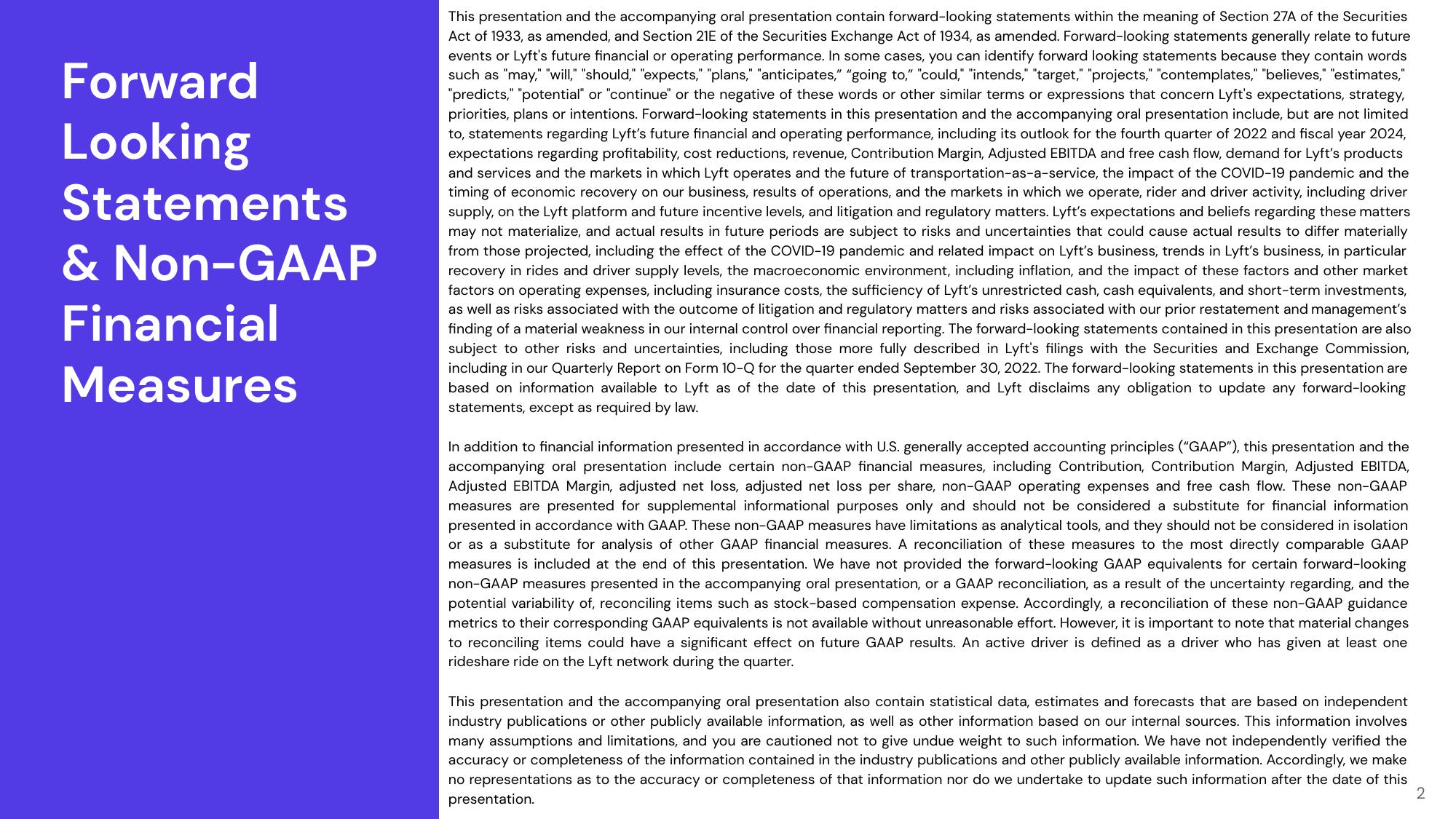Lyft Investor Presentation Deck
Forward
Looking
Statements
& Non-GAAP
Financial
Measures
This presentation and the accompanying oral presentation contain forward-looking statements within the meaning of Section 27A of the Securities
Act of 1933, as amended, and Section 21E of the Securities Exchange Act of 1934, as amended. Forward-looking statements generally relate to future
events or Lyft's future financial or operating performance. In some cases, you can identify forward looking statements because they contain words
such as "may," "will," "should," "expects," "plans," "anticipates," "going to," "could," "intends," "target," "projects," "contemplates," "believes," "estimates,"
"predicts," "potential" or "continue" or the negative of these words or other similar terms or expressions that concern Lyft's expectations, strategy,
priorities, plans or intentions. Forward-looking statements in this presentation and the accompanying oral presentation include, but are not limited
to, statements regarding Lyft's future financial and operating performance, including its outlook for the fourth quarter of 2022 and fiscal year 2024,
expectations regarding profitability, cost reductions, revenue, Contribution Margin, Adjusted EBITDA and free cash flow, demand for Lyft's products
and services and the markets in which Lyft operates and the future of transportation-as-a-service, the impact of the COVID-19 pandemic and the
timing of economic recovery on our business, results of operations, and the markets in which we operate, rider and driver activity, including driver
supply, on the Lyft platform and future incentive levels, and litigation and regulatory matters. Lyft's expectations and beliefs regarding these matters
may not materialize, and actual results in future periods are subject to risks and uncertainties that could cause actual results to differ materially
from those projected, including the effect of the COVID-19 pandemic and related impact on Lyft's business, trends in Lyft's business, in particular
recovery in rides and driver supply levels, the macroeconomic environment, including inflation, and the impact of these factors and other market
factors on operating expenses, including insurance costs, the sufficiency of Lyft's unrestricted cash, cash equivalents, and short-term investments,
as well as risks associated with the outcome of litigation and regulatory matters and risks associated with our prior restatement and management's
finding of a material weakness in our internal control over financial reporting. The forward-looking statements contained in this presentation are also
subject to other risks and uncertainties, including those more fully described in Lyft's filings with the Securities and Exchange Commission,
including in our Quarterly Report on Form 10-Q for the quarter ended September 30, 2022. The forward-looking statements in this presentation are
based on information available to Lyft as of the date of this presentation, and Lyft disclaims any obligation to update any forward-looking
statements, except as required by law.
In addition to financial information presented in accordance with U.S. generally accepted accounting principles ("GAAP"), this presentation and the
accompanying oral presentation include certain non-GAAP financial measures, including Contribution, Contribution Margin, Adjusted EBITDA,
Adjusted EBITDA Margin, adjusted net loss, adjusted net loss per share, non-GAAP operating expenses and free cash flow. These non-GAAP
measures are presented for supplemental informational purposes only and should not be considered a substitute for financial information
presented in accordance with GAAP. These non-GAAP measures have limitations as analytical tools, and they should not be considered in isolation
or as a substitute for analysis of other GAAP financial measures. A reconciliation of these measures to the most directly comparable GAAP
measures is included at the end of this presentation. We have not provided the forward-looking GAAP equivalents for certain forward-looking
non-GAAP measures presented in the accompanying oral presentation, or a GAAP reconciliation, as a result of the uncertainty regarding, and the
potential variability of, reconciling items such as stock-based compensation expense. Accordingly, a reconciliation of these non-GAAP guidance
metrics to their corresponding GAAP equivalents is not available without unreasonable effort. However, it is important to note that material changes
to reconciling items could have a significant effect on future GAAP results. An active driver is defined as a driver who has given at least one
rideshare ride on the Lyft network during the quarter.
This presentation and the accompanying oral presentation also contain statistical data, estimates and forecasts that are based on independent
industry publications or other publicly available information, as well as other information based on our internal sources. This information involves
many assumptions and limitations, and you are cautioned not to give undue weight to such information. We have not independently verified the
accuracy or completeness of the information contained in the industry publications and other publicly available information. Accordingly, we make
no representations as to the accuracy or completeness of that information nor do we undertake to update such information after the date of this
2
presentation.View entire presentation